論説

概要
- The “4D” approach to growing in China (Design for Chinese consumers, Decide in China, Deliver at “China speed” in a Digital way) is a key factor in the success of multinationals selling fast-moving consumer goods in China.
- 4D enables multinationals to think and act like local companies—and all local companies are taking their cues from the Chinese insurgents that are rewriting the playbook.
- China’s new “unicorns”—fully digital native—can test 10 ideas at the same time and rapidly roll out the ones that work.
- Chinese companies have taught us that local speed is paramount, as it leads to scale. Global scale does not necessarily lead to local scale, and sometimes, global scale can be an obstacle to local scale if it slows things down.
阅读中文版报告 Read the brief in Chinese
Three years ago, we wrote about the mounting threat that fast-growing local insurgent companies posed for multinational consumer goods companies in China. In our Bain Brief “Consumer Products: Now’s the Time to Double Down in China,” we explained how, increasingly, the foreign companies that were able to gain an edge against this hot competition were using a 4D approach:
- Design for Chinese consumers
- Decide in China
- Deliver at China speed …
- … in a Digital way
Since then, the 4D model has shifted the fortunes of a select class of foreign brands, generating interest in how to adopt the 4D mentality. While a procession of multinationals in both the retail and consumer products sectors have beat a retreat from China, others are staying and surfacing as winners in the world’s largest and most important consumer market.
As the successes in China of companies like AB InBev (ABI), Kimberly-Clark, and L’Oréal come into sharper focus, it’s clear that 4D was a key factor in helping them compete not only against their multinational and domestic counterparts, but against Chinese insurgents. The evidence of their efforts is everywhere. You see it on the supermarket shelves on cans of Budweiser with gold and premium packaging cues (“icon of premiumness”) to cater to local preferences, or special Budweiser Supreme gold and premium packaging for celebration meals.
You see it online, where L’Oréal and Kimberly-Clark have become best in class among global companies for their digital marketing on the uniquely Chinese livestreaming channels. In fact, L’Oréal deemed livestreaming so important that it quickly established an internal talent pool to serve the new channel instead of depending on an outside agency.
These and other moves are enabling multinationals to think and act like local companies—and local companies are taking their cues from the Chinese insurgents that are rewriting the playbook for success. Young insurgents are typically digital native, data enabled, well-funded by venture capital, asset light, and focused on hypergrowth. Many are capturing more than their share of the growth across the categories in which they compete even if not all succeed, as reported in the latest China Shopper Report, released in December 2021: “A Sudden Slowdown in 2021’s FMCG Recovery … and the Mixed Fate of China’s Insurgent Brands.”
Consider the meteoric rise of Genki Forest, which has achieved amazing success in the soft drink sector in less than five years and was on track to reach $1 billion in revenues in 2021. Or look at the impressive advances made by Florasis in the color cosmetics sector, or by SHEIN in the fast-fashion apparel sector, with sales estimated to have reached $10 billion. All of these youthful companies are beating out decades-old category powerhouses through digitally enabled playbooks that leverage consumer feedback loops for faster and more successful innovations and better-targeted consumer engagement. And these previously unknown brands were far from alone. In fact, 700 insurgents outpaced both foreign and domestic competitors to reach the top of their product categories in Singles Day 2021 sales (see Figure 1).
Chinese local insurgents are becoming the real competitors and are already the best performers in many categories
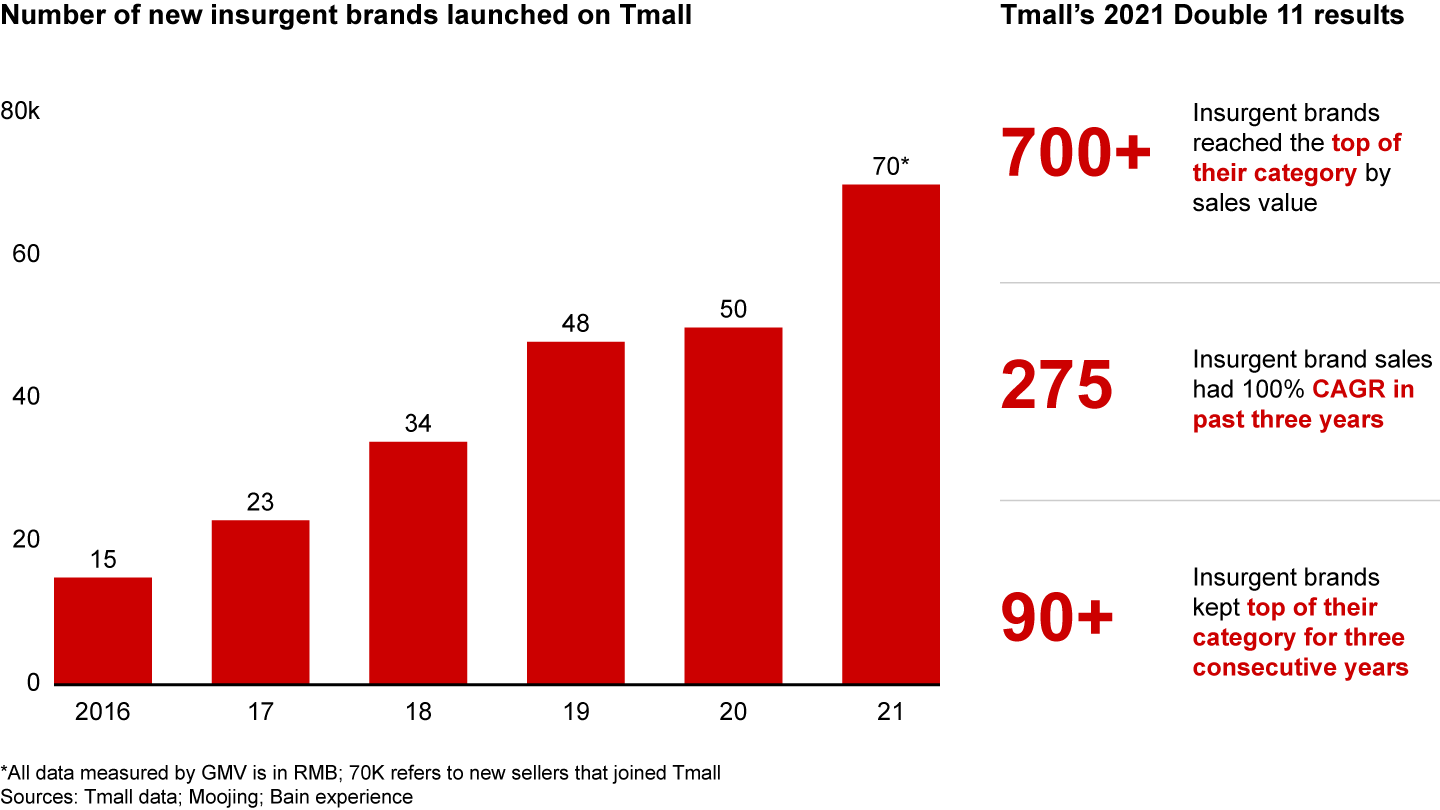
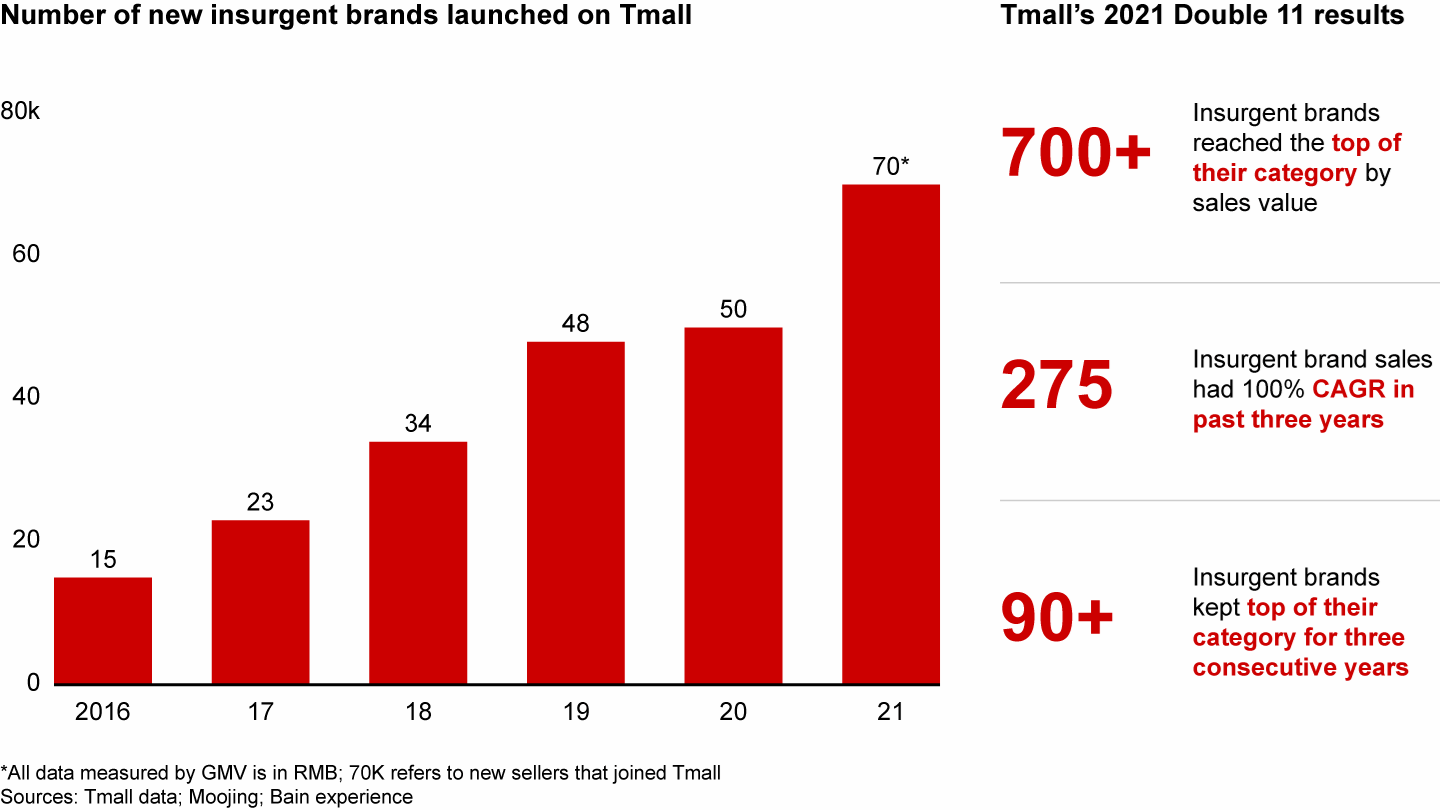
The numbers tell us that many local insurgents show no signs of losing their competitive power. Babycare, founded in 2014, achieved 100% annual growth with its disruptive product innovation model that maximizes the lifetime value of mothers. The company introduces no fewer than 700 stock-keeping units a year, many of them within a few months of creation. Its laser focus on digital has helped it generate an audience of 1 million mothers and, as a result, a vast potential for adjacency sales at low costs.
Another example is Milkground, recently acquired by Mengniu. Launched in 2016, Milkground is the only public company in China with cheese as a core business. During the past five years it grew its share in the cheese market from about 4% to about 28% and became the category leader with around $435 million in revenues in 2020. Milkground has developed the cheese stick as its “hero” product, with a clear understanding of consumer demand, leading product quality, and effective investment in brand building and channel development.
The 4D model is the secret to the success of these insurgents, but it also is fueling the growth of multinationals that are acquired by Chinese companies—and is the approach that established Chinese companies use to become powerful competitors by transforming themselves into “scale insurgents.”
When Wumart acquired Metro in late 2019, it quickly made targeted moves that would adapt the traditional German company to win in China, where swift innovation and digital sophistication are table stakes. For example, it designed for the Chinese market by moving into the locally popular club store format, something the retailer hasn’t attempted in other markets, except with business customers. It transformed for deciding in China. Pre-acquisition, more than 100 decisions were made at the headquarters or regional level—post-acquisition the vast majority of those decisions were put in the hands of local decision makers. Wumart also digitalized for China by, among other moves, replacing the IT system for its D-Mall online and offline integration solution and adding a Metro mobile app.
And as such outsized numbers suggest, there is a go-big-or-go-home imperative for multinationals in China. In fact, if there were a fifth “D,” it would be “Dare to be big.” Despite a recently slowing economy, China is the world’s largest consumer market and remains the hottest consumer story. It’s not a stretch to say that the next China is China.
How to establish a 4D model? We’ll look at the process for each “D” one by one (see Figure 2).
Winning in China requires multinationals to compete like insurgent Chinese companies, using the 4D model
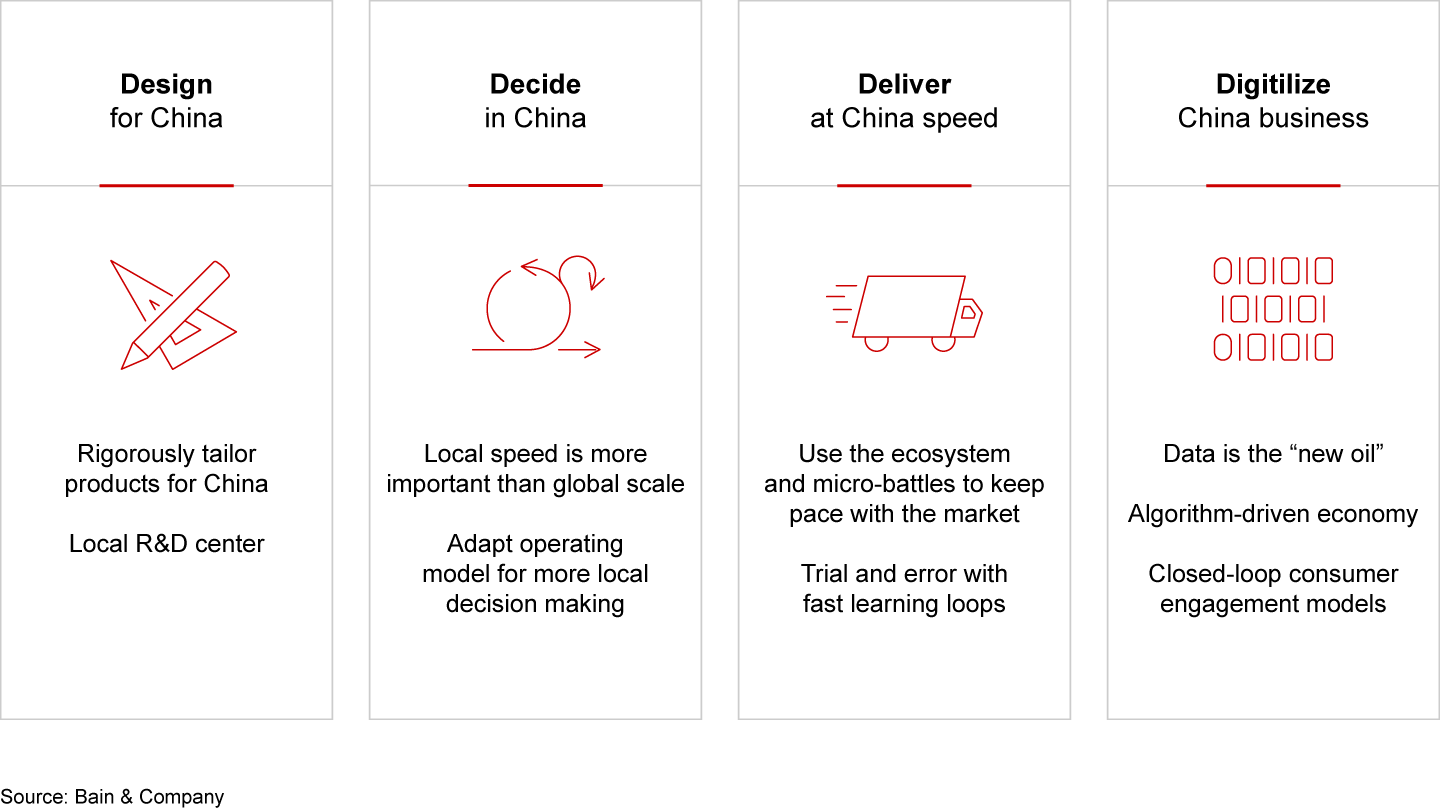
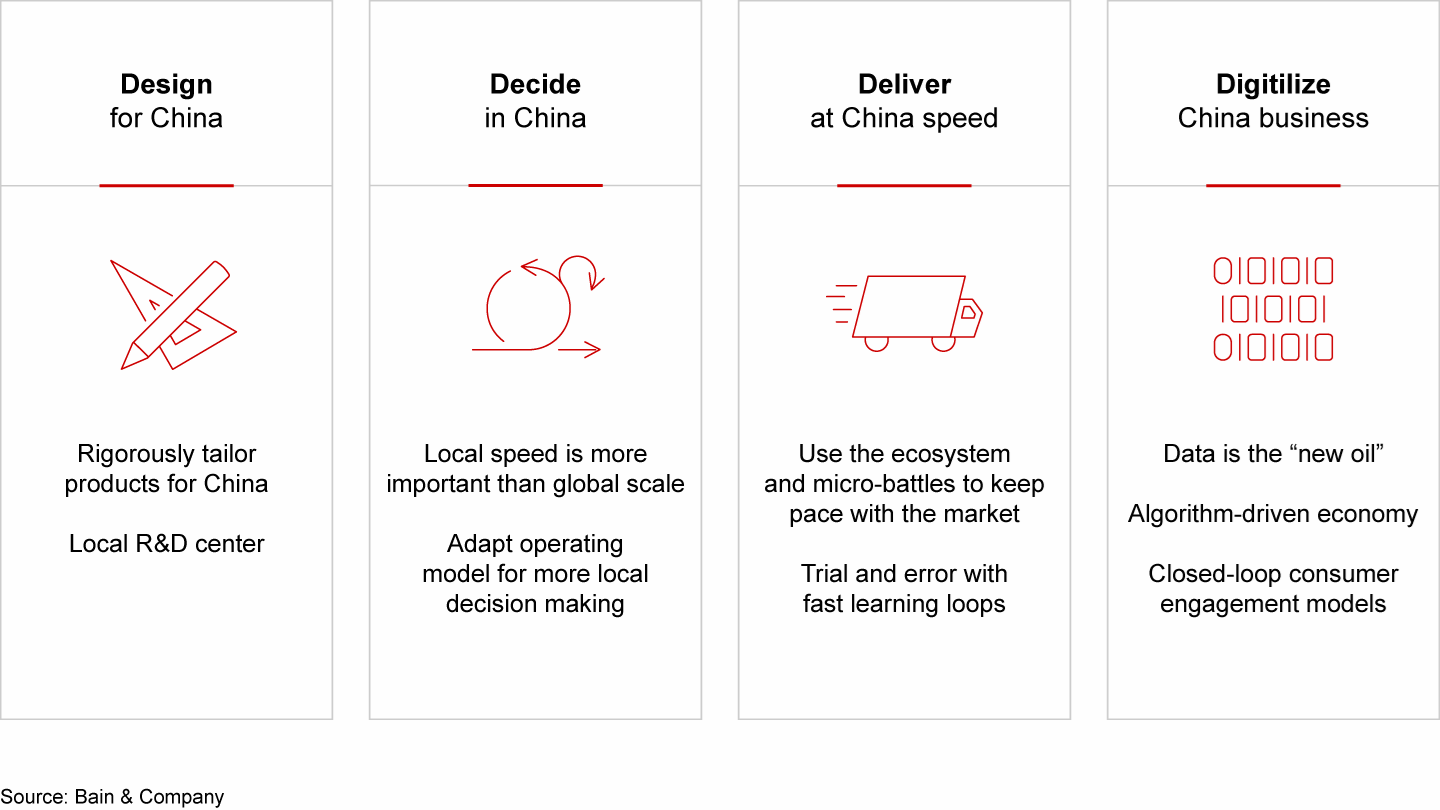
Design for Chinese consumers
This is the “D” where multinationals have made the most progress in the past few years. China has become a global hub for innovation, with more and more multinationals establishing their R&D centers here. There are now more than 2,000 multinational R&D centers in China. Recent examples include Nestlé China’s new China R&D center in Beijing, and its technology hub in Shenzhen, and the dedicated innovation office that Shiseido built in Hangzhou to work more closely with Alibaba.
The designs emerging from those centers span three main dimensions.
First, there are specific product formulations, like Corona beer with sea salt and guava, as well as flavored beers like Budweiser ME3. Another example is Kimberly-Clark’s Huggies, with their light and thin technology in four different series (silver, gold, platinum, and heart diamond). In fact, all of Kimberly-Clark’s China innovations come from China.
Similarly, China-specific consumer insights led to the development of the Eye Cream for Face product in a small tube for the L’Oréal Paris brand in 2018. The innovation has become an important pillar of the L’Oréal Paris brand in China. In fact, all L’Oréal Paris innovations in China, whether in product formulation or packaging or both, are developed domestically based on Chinese consumer insights.
Second, China is the home to amazingly creative packaging, especially during the Chinese New Year and other festivals. Localized packaging also includes personalized packaging, which is spreading across many product categories.
Third, local design extends to consumer engagement and marketing campaigns that follow the Chinese marketing calendar and large festivals, and which are aimed at the unique local digital platforms. These campaigns feature Chinese celebrities and key opinion leaders, with customized passion points and messages, all consistent with the global brand image.
Even the centrally managed design and creative centers of global luxury brands are influenced by Chinese consumers: Recent trends around streetwear, casualwear, and sportswear by luxury brands originate with Chinese consumers, who often are 15 to 20 years younger than their Western counterparts.
Despite the progress that some multinationals and large Chinese incumbents have achieved, many still rely on traditional “stage and gate” innovation approaches that aim for the perfect innovation. Instead, local insurgents like Genki Forest or Babycare use Agile sprints intended to develop several minimum viable products and test them rapidly in the market to get consumer feedback. They work with original equipment manufacturers or original design manufacturers and digital platforms to speed up the process, as required.
Decide in China
Among the biggest benefits of being a domestic company is that decisions don’t need to be run through global or regional headquarters. That’s why the most successful multinationals create a China-centric operating model. This requires perfecting five building blocks (see Figure 3).
Five building blocks are critical to adopting the “Decide in China” operating model
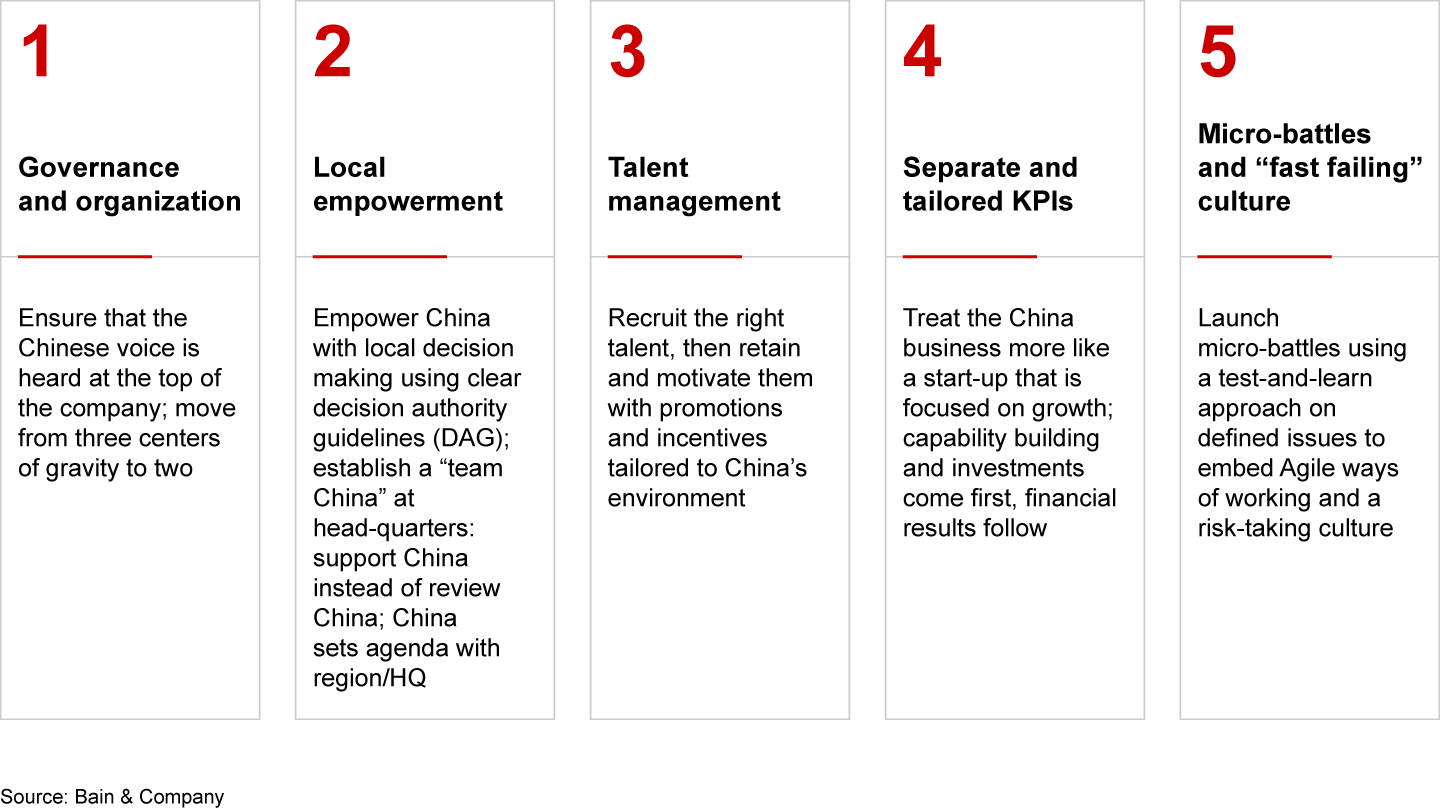
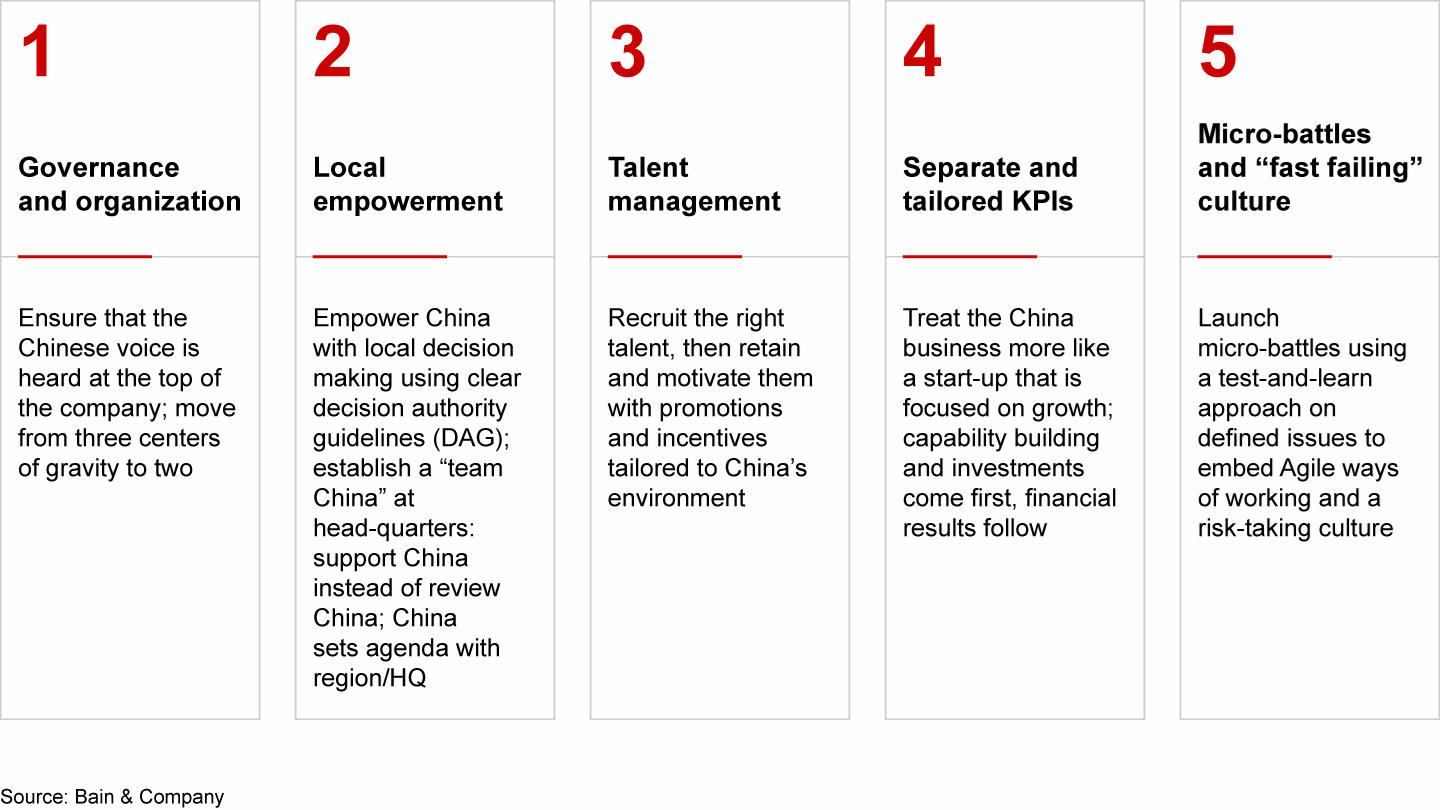
Governance and organization. Companies deploy a range of organization models to localize and accelerate their decisions and give China more visibility and influence at global headquarters. For example, Coke has made Coke Greater China and Mongolia one of nine global zones that report directly to the company’s chief operation officer. Many foreign companies have reduced the decision-making process from three centers of gravity (HQ, Asia-Pacific, China) to two. For example, the L’Oréal head of North Asia, based in Shanghai, is also the head of the China business, and has been on the company’s executive committee for several years.
Local empowerment. Indeed, China is like no other market when it comes to the speed at which products win or fail or the speed at which trends take root or wither. So, the speed at which decisions are made and action is taken is essential for scaling here. That’s why the most successful multinationals in the market avoid the headwinds from global headquarters. They agree on a delegation of authority framework that gives lots of freedom to the China team. As we will explain, this freedom comes with responsibility.
Moreover, these companies support China instead of review China. They let China set the agenda with the headquarters instead of the other way around. We still see too many companies where the China leadership team explains China to its HQ instead of focusing on building the China business and moving fast. But there’s evidence of progress. Chinese executives now head the China units of Nestlé, Procter & Gamble, and other large multinationals.
Talent management. The race for talent is different in China than anywhere else in the world—and multinationals are losing. In a 2018 joint report with LinkedIn, we saw that over the previous five years, business leaders moved from foreign to local companies at five times the rate that they moved from local to foreign companies. The situation has probably worsened since then.
Multinationals face a thorny challenge. On the one hand, they need to maintain consistency across the world in such areas as grading and incentive systems. On the other hand, they need to deliver on the specific retention needs of Chinese talent. For example, top Chinese talent is more and more attracted to the alternative compensation structures, stock options, fast pace, and ability to influence decision making typically offered by large domestic Internet companies and start-ups alike.
China is like no other market when it comes to the speed at which products win or fail or the speed at which trends take root or wither.
Foreign companies hoping to fill their talent gap in China need to add these and other elements to the existing incentives that lure in domestic employees: specific grant programs, loyalty-based incentive programs, and training and education options. ABI is one multinational that is moving in this direction. Its September 2019 listing on the Hong Kong Stock Exchange set the stage for an attractive incentive: compensation linked to company performance in Asia-Pacific, rather than predominantly global performance.
Separate and tailored key performance indicators (KPIs). When it comes to KPIs, the most effective multinationals treat the China business more like a start-up in which capability building and investments come first, and financial results follow. This flies in the face of the tradition of having KPIs that are the same or similar to those in the rest of the world. Taking a cue from successful young insurgents, KPIs are linked to growth and innovation instead of short-term profit.
This approach translates into high levels of value creation through multiple rounds of financing and subsequent IPOs. It is very different from the pure profit-and-loss focus on EBIT or EBITDA that multinationals tend to follow globally and in China.
Micro-battles and “fast failing” culture. Winners in China crack tough business issues with speed by focusing on small initiatives, scaling them effectively and building learning systems and capabilities to continuously improve those solutions. These micro-battles allow companies to test and learn on specifically defined issues and to instill Agile ways of working. The China digital ecosystem provides a super-fast consumer feedback loop on media campaigns or on new product launches, allowing brands to fail quickly and course correct. This Agile approach to innovation and consumer engagement is the trademark of digital-enabled insurgent brands.
Deliver at China speed
There are many stories that show what it looks like to deliver at China speed. Consider the buildout of hospitals in Wuhan over a few short weeks during the earliest days of the pandemic. There’s also the Tesla experience. Starting with an empty piece of land in January 2019, the iconic electric car company built a finished factory by December and had cars rolling out from its assembly line by December 30, demonstrating that multinationals can move at China speed.
Once again, it is impossible to overestimate the importance of speed in China. Chinese consumers are quick to adopt new products or embrace a new channel or platform. Chinese competitors are equally quick to copy a company’s winning product. In beer, for example, local competitors sometimes copy an innovation in as little as three months—in other markets it might take a year (or not happen at all).
China’s new unicorns—fully digital native—can test 10 ideas at the same time and rapidly roll out the ones that work. With China’s size and available platforms, brands can reach millions of consumers quickly and effectively—but the key is speed in innovation and reaction to new developments.
Genki Forest integrated consumer feedback data into product development and R&D. As a result, the young company outpaces incumbents in its R&D cycle and product launches with fast decision making and product iteration.
China speed is also enabled by the ecosystem model of organization and cooperation among companies. Each company focuses only on what it is good at and relies on other companies to do what they are good at, in a win-win collaboration model. Alibaba and other China digital platforms were the first to implement such an ecosystem-based operating model at scale. In his 2018 book on Alibaba, Chief Strategy Officer Ming Zeng described the model behind the phenomenal growth and success of Alibaba as smart business that results from the powerful combination of a coordinated network of millions of participants and data intelligence—a combination that drives efficiency and speed.
In China, local companies have introduced a new competitive paradigm that presents a major challenge to multinationals: Local speed is paramount, as it leads to scale. Global scale does not necessarily lead to local scale, and sometimes, global scale can be an obstacle to local scale if it slows things down.
Global scale can be a competitive advantage in many international markets, which is why it is hard for many foreign companies to adapt to the China pattern around speed. As one CEO of a successful foreign company puts it: “In China, we don’t take time to explain what we want to do. We just do it first and we explain after what we did. It’s better to spend time and energy to define and execute what you need to do in China rather than to ask for permission on what you need to do. So that’s why you need to have a certain trust from the organization and a certain framework. But you need to be free in this framework to be able to address the continuous disruptions of this market.”
Deliver in a digital way
China is the most digitalized consumer market in the world across whatever dimension you choose. The country is No. 1 in e-commerce, with e-commerce sales representing about 30% of total retail sales in 2020. One-third of China’s population used social commerce in 2020. Nearly 30% of e-commerce buyers have purchased through livestreaming. And about 40% of all food is ordered online. Chinese smartphone users spend four hours and 34 minutes per day on their smartphone, 48 minutes more than US adult smartphone users spend.
The Chinese digital ecosystem is unique and advanced for two main reasons. For one thing, it is data rich, giving companies an unparalleled ability to leverage consumer data for marketing or promotion campaigns. Also, it is fast changing, with a consumer-centric revolution happening seemingly all the time. For example, Pinduoduo did not really exist five years ago. Today, it is among the top Chinese social media platforms in terms of monthly users. Or consider the stunning ascent of retail livestreaming. Under two years old, it has become a major e-commerce platform. And then there is Douyin, which for the past two years has been the fastest-growing platform by gross merchandise volume, representing a new content-based e-commerce model.
In this context, it is not surprising that the winning brands are the fastest at leveraging this new digital ecosystem. For example, Kimberly-Clark’s business in China is heavily digital. The company focuses on digital customer acquisition and engagement, reaching out digitally to millions of new mothers each year. It has developed in-house digital capabilities to quickly design the strategy, activation components, and execution guidelines for TP (Taobao Partners) or agencies. In fact, more and more of the TPs and agencies’ work is internalized for faster reactivity. It uses advanced digital tools like TMIC and Kuazi for research and consumer intelligence for fast learning and adaptations.
Kimberly-Clark heavily invests in digital media (including e-commerce, social media, short videos, and vertical apps) to recruit new consumers and the company uses tools to measure the effectiveness of different campaigns and media. Nearly all of its media spend is online. Kimberly-Clark is known for adopting innovative marketing and sales channels—using livestreaming that combines branding and sales performance, for example. The digital emphasis is paying off, with 70% of its baby diapers and 30% of its feminine care products now sold online. The company deeply penetrated not only online, but also offline channels, supported by omnichannel capabilities. These digital achievements are possible due to their Agile ways of working and abilities to quickly test and learn new ideas.
China for the world
Finally, the 4D model isn’t just for succeeding in China; it is also for giving back to the global organization. The most effective multinationals are not only making China a must-win market but also are using it as a testing ground for everything from product designs to route-to-market approaches that can be replicated elsewhere in the world.
In 2018, L’Oréal Paris haircare launched a new HA Moisture haircare product integrating hyaluronic acid into its formulation. It was based on specific consumer insights showing a tension between dry hair and an oily scalp that no other available shampoo was addressing. The company launched a full suite of products alongside the shampoo and then successfully introduced them in Europe and Latin America.
Historically, all innovations for L’Oréal’s Kerastase brand have been developed in Paris, where the brand is based. However, the Kerastase China team developed a cleansing clay based on Chinese consumer and stylist insights around the need for a product that deeply cleans the hair and scalp. The product has a high concentration of clay and is sold exclusively in salons. It was successfully launched in Europe after China.
Similarly, Huggies innovations born in China were sold in Australia and New Zealand and have since become key to the brand’s success in those markets.
Giving back to HQ is critical for multinationals to benefit from what they learn in the world’s biggest market—and to continue earning trust from the global organization. Here, too, there are abundant signs of companies getting it right—and in different ways.
ABI sets the standard for exporting what succeeds in China. The beverage company’s China lessons influenced its global digital transformation agenda. In 2019, ABI’s entire global leadership team spent a week in Shenzhen for a deep immersion into the China digital landscape, which then helped it define the global digital transformation agenda for the whole company. In addition, ABI is exporting China-born business models. For example, the High End Company, which is devoted to superpremium brands like Corona & Hoegaarden, was rolled out to numerous ABI markets in the years after it proved successful in China, which has served as a launching pad for everything from geographic expansion to marketing positioning for ABI.
One of the major reasons why China is such a strong place for testing brands is that its media landscape is changing and fragmenting in a way that will spread to all other markets. China is where consumer goods companies can hone their ability to work with key opinion leaders, to allocate budgets across different platforms and types of digital campaigns, and to understand how to profit from the likes of Douyin before they become global powerhouses—and before the competition.
These consumer goods companies and retailers go to China as multinationals and, by adopting a 4D model, learn how to become dynamic scale insurgents capable of winning there and everywhere.